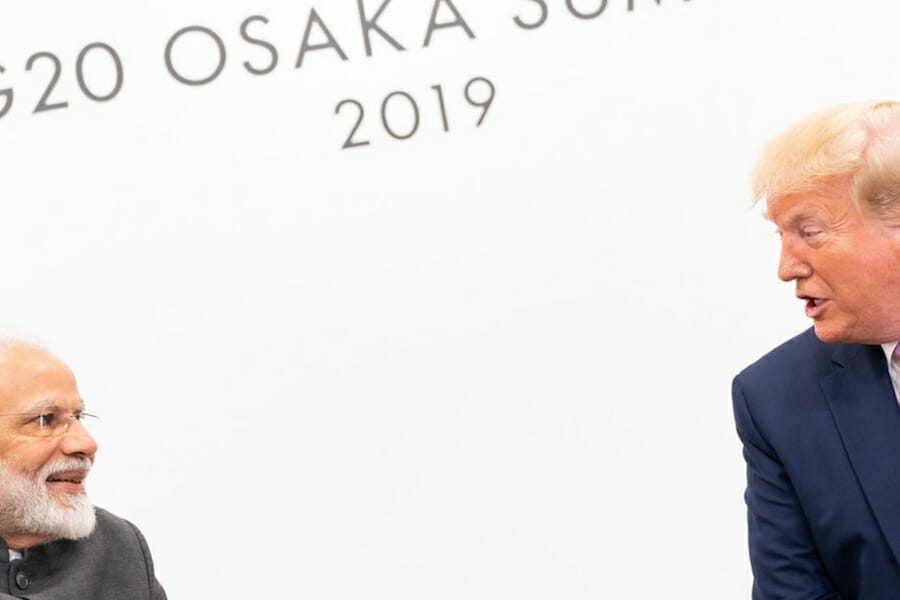
Standing Against China: The Future of the Indo-American Alliance
“Let her sleep, for when she wakes, she will shake the world.”
It was Napoleon Bonaparte who warned nearly two centuries ago of the immense potential of the then dormant China. Those words have never seemed more relevant than in our contemporary age as China has now positioned itself as the preeminent competitor with the United States for economic and geopolitical dominance.
While one could have once envisioned a utopian world in which the current hyperpower of the United States and the rising superpower of China coexisted in a symbiotic relationship, that is not the reality that we live in. Battle lines have been drawn and the interests of the two countries are increasingly at odds.
For China, the jury is already out. But the same is not true for India.
In more ways than one, India can be seen as, for lack of a better term, “the next China.” With annual GDP growth projected to be over 7% for the next few years, India has the potential to continue its significant economic development and become the region’s economic powerhouse. And with a population that is expected to exceed China’s by 2027, and is on average 10 years younger, India has the supply of labor necessary to sustain rapid growth.
All of this points to the possibility for the future of Asia to not be defined by Chinese hegemony. Certainly, that is a possibility that is in the best interest of the United States, both economically and militarily, and American foreign policy should reflect that reality.
Unfortunately, recent disputes between the Trump administration and the Indian government have heightened divisions between the two countries. Among the points of contention are rounds of tariffs that have proven to be one of the cornerstones of President Trump’s foreign policy. Beginning with the withdrawal of preferred status for India that allowed more than $5 billion of goods to be shipped to the United States duty-free, India has retaliated with its own tariffs. Further, India is moving forward with new laws that will further regulate global e-commerce, laws that will surely be a thorn in the side of American tech companies like Google.
Even though diplomats and leaders of both countries continue to paint a rosy picture of the US-Indian relationship, lauding the countries’ shared democratic values and history of friendship, it is obvious that tensions remain real and significant. Recently, on his trip to New Delhi, Secretary of State Pompeo attempted to defuse such tensions, characterizing the two nations as “Great Friends,” amid escalating disputes between the two countries.
While some of the tension has arisen from India’s recent purchase of Russian S-400 missile systems, much of the disagreement between the two countries centers around trade. Speaking to this point, Secretary Pompeo expressed the desire of the United States to seek “greater market access” and the “removal of trade barriers.” Yet, recent actions on the part of the United States have hindered progress toward these goals.
Adding to the removal of India’s preferential trading status and the retaliatory tariffs, President Trump’s recent tweets have further undermined the United States’ commitment to building an economic partnership between the two countries. Broadly, President Trump criticized the United States assuming an outsized role in protecting the world’s shipping lanes, a move that emphasizes the current administration’s departure from supporting the global economic order that has been the cornerstone of US foreign policy for decades.
….a dangerous journey. We don’t even need to be there in that the U.S. has just become (by far) the largest producer of Energy anywhere in the world! The U.S. request for Iran is very simple – No Nuclear Weapons and No Further Sponsoring of Terror!
— Donald J. Trump (@realDonaldTrump) June 24, 2019
This kind of rhetoric undermines American credibility at the negotiating table when it attempts to achieve Secretary Pompeo’s stated goals. It begs a reasonable question that the United States, at the moment, does not seem to have an answer for: how can you preach expanding economic liberalism when you yourself has undermined the global norms that have made it so effective?
If this United States is going to forge an alliance with India that will potentially serve as a bulwark against regional and global Chinese hegemony, this is a problem that must be resolved. The US must recommit itself to liberal economic norms, not just for itself, but for the development of nations around the world with whom we should be attempting to curry favor.
Undoubtedly, India has much to gain from pursuing an economic partnership with the United States. India has long been plagued domestically by an overly protectionist economy and a subsidy state that has hindered growth and stalled its eventual rise. With the right set of policies of liberalization, India has the potential to exceed what is an already remarkable rate of growth. And the United States should serve as the shining example for reform and a steadfast partner in doing so.
Even more, India has historically not found a friend in China. From tensions stemming from China’s protection of Pakistan on terror-related issues to the prospect of China achieving dominance of Asia and beyond with its Belt and Road Initiative, India is not eager to cozy up to Beijing any time soon. Yet, the realist in every Indian official can see the writing on the wall when it comes to the emerging geopolitical landscape that, in all likelihood, will be even more dominated by China.
They are going to have to play ball with Washington or Beijing, and it is clear what their choice is. Luckily, for the United States, their choice could not be more in line with American interests, and it offers an opportunity for the US to have a relationship with a great Asian power drastically different than that which exists with China.
It is not a new idea in US foreign policy to develop commercial and military ties to counter China. After all, that was one of the driving forces of the doomed TPP. Yet, despite the Obama administration’s pivot to Asia and lip service from the Trump administration, the United States has failed to achieve the progress that will be required to stand up to China in the 21st century and beyond.
We’ve been talking the talk for quite a while. It’s time that we start walking the walk.
India is potentially one of the world’s next great powers. This is not a reality that the United States, or any other country in the world for that matter, should take lightly. It is incumbent upon us to ensure, for future generations, that the world’s next great power does not follow the course of China in becoming another geopolitical rival. And we should do so with all due haste.

